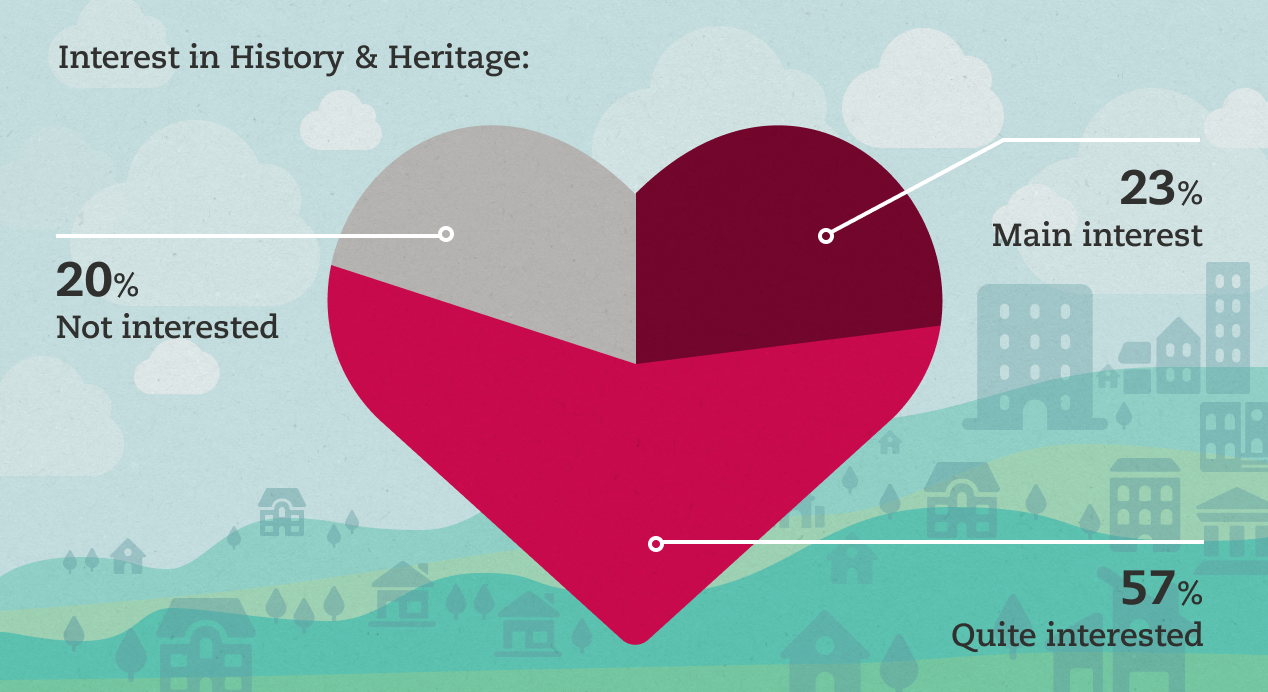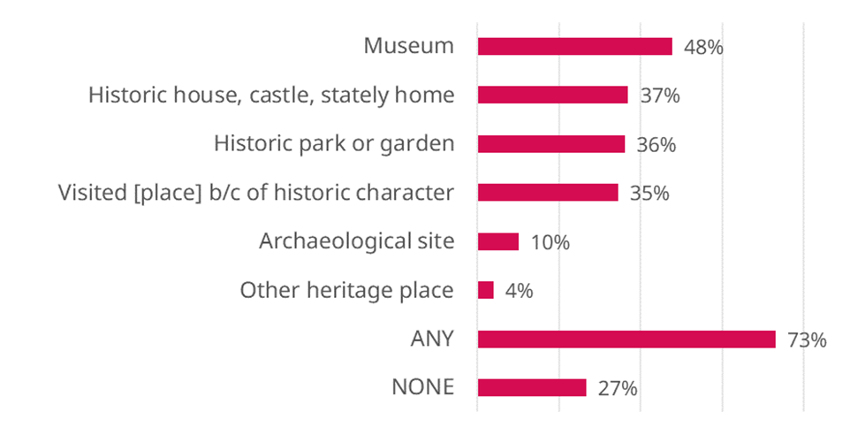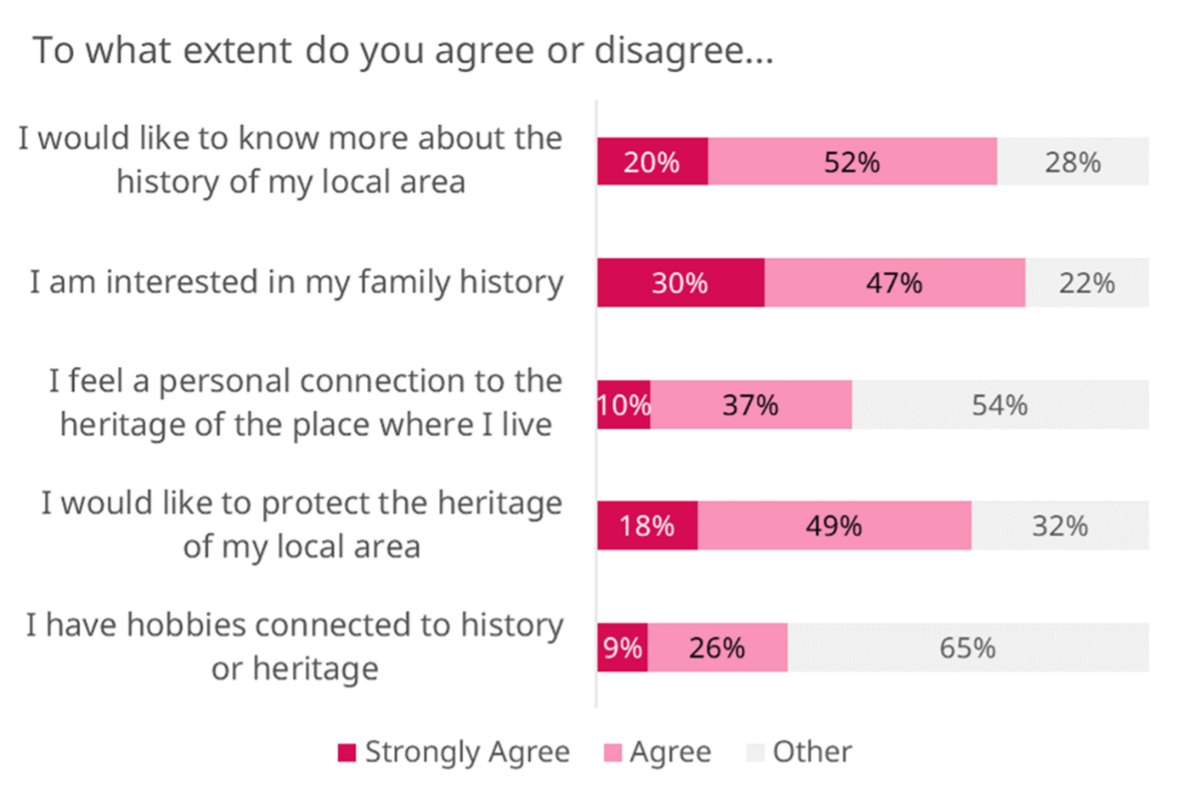Interest in history and heritage
June 2024
This research is from The Audience Agency's nationwide longitudinal (ongoing) panel survey of changing views about participating in creative and cultural activities through the recent and ongoing crises, and beyond, the Cultural Participation Monitor.
Themes
- Cultural Participation
-
Built heritage
-
Museums & archives
Heritage is broadly popular with the general population, with high proportions saying that it’s an interest of theirs.

This interest is widespread, with the proportion who have history and heritage as a main interest varying only from 17% to 26% for most demographic categories (e.g. age, occupation, education, gender, ethnicity, indices of multiple deprivation quartiles etc). The only exception to this was those with higher degrees, among whom 34% said it was a main interest.
High proportions also attending heritage sites of different types, with 73% attending at least one in the previous 12 months:

High proportions are also interested in heritage in more specific ways: in knowing about their local area (72% agree or strongly agree) and, particularly, in being interested in their family history (77%). Personal connection makes heritage more relevant and of greater interest, as is demonstrated by the increase from 20% to 30% who ‘strongly agree’ when the focus shifts from local history to family history.

The proportion who felt a personal connection to the heritage of their local area was lower than those interested in knowing more about it, showing that an appetite to know more wasn’t restricted to those who felt personally connected to it. Similarly, there was also a higher proportion who want to protect local heritage (almost one on five strongly agreeing, and two thirds agreeing overall). This emphasises the breadth of support for local heritage, both in terms of engagement and preservation.
We also tested some statements that were more challenging towards heritage: ‘history isn’t relevant in the modern world’ (only 12% strongly agree/agree) and ‘Focusing on history pushes people apart’ (only 19% strongly agree/agree). The proportions agreeing with these were higher in London (17% and 28% respectively), among younger groups (16-24 19% and 28%; 25-44 19% and 27%) and among Asian/Asian British (28% and 35%) and Black/Black British (20% and 31%) respondents [although NB smaller samples of 142 and 139 for each of the latter two groups]. Those with children were also more likely to agree with both of these statements (21% and 28%).
There is a similar picture for those agreeing that ‘heritage is more relevant for other people than it is for me’. This is agreed to by 30% overall, but 36% in London, 50% of 16-24s, 39% of 25-44s, 50% of Asian/Asian British and 43% of Black/Black British respondents, as well as 37% of those with children. This pattern isn’t, however, matched by the profile of those agreeing about interest in local and family history (indeed, younger people were more likely to be interested in family history: 85% of 16-24s compared to 78% overall).
Together these suggest an overall picture of enthusiasm for heritage across social groups, but a greater – if still not generally predominant - sense that it can be divisive, and less relevant both personally and in general among those younger, more diverse and London-based groups, as well as among parents. For these groups, there seems to be a shift to a greater sense of the importance of identity and personal/family narratives, and heritage as something you choose to find out about or do, rather than history as something which is unifying, relevant and ‘given’ (including through education).
What these results cannot show in relation to the ages of respondents, of course, is whether these differences of attitude are age effects or cohort effects (i.e. whether they are because of respondents’ age and could be expected to change as they age, or whether those values are likely to persist over time among those groups, even as they get older). It may suggest a shift in attitude which will spread through the age bands (perhaps even through the rest of the country) over time. History and heritage would, in that case, still have a key role to play and be of great interest to people. However, personal and local relevance and the ability to manage your own relationship to heritage could become increasingly important.
Related videos
Cultural Participation Monitor | Latest Findings on Audience Attitude and Behaviours
Watch nowTEA Break: Bad behaviour? - What types of behaviour people prefer when attending culture
Watch nowTEA Break | From Interest into Action
Watch nowTEA Break | More Insights on Changing Audiences
Watch nowTEA Break | Key Changing Audiences for Art Forms
Watch nowOther findings from Wave 10 | Mar 2024 | Places. event timings, heritage, social & digital
-
Opinions on the display of human remains in museums
Debate about the display of human remains has been in the news recently, here's what our research found.
-
Use of social and digital by Audience Spectrum
Use of digital media and digital varies between Audience Spectrum, suggesting different potential routes to reach different segments.
-
Attitudes to heritage
We asked the extent to which people agreed or disagreed with a range of statements about history and heritage, to better understand the attitudes which people bring to their engagement. These results were surprising in a number of ways: neither consistently conforming to a traditional nor a progressive perspective.
Other findings about Built heritage, Museums & archives
-
Attitudes to heritage
June 2024
-
Opinions on the display of human remains in museums
August 2025
-
Museums Audience Report
November 2018
